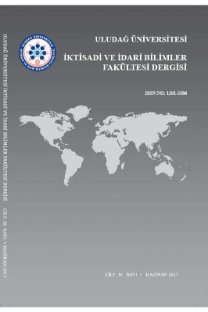Vergi Harcamaları: Harcama Vergileri Açısından Analizi
Vergiler aracılığıyla devletin yaptığı harcamalar, vergi harcamaları olarak nitelendirilmektedir. Vergi harcaması yaygın olarak; belirli ekonomik ve sosyal amaçlara ulaşmak için oluşturulan ve gelir kayıplarını içeren, standart ve genel kabul görmüş bir vergi yapısından ayrılma olarak tanımlanır. Uygulamada vergi harcamaları; vergi muafiyet ve istisnaları, vergi kredisi, düşük vergi oranı ve vergi ertelemesinden oluşmaktadır. Vergi harcamalarını esas alan rapor uygulaması ilk kez 1960'ların sonunda Almanya ve Amerika'da başlatılmıştır. Bu ülkeleri diğer gelişmiş ülkeler takip etmiştir (IMF, Manual on Fiscal Transparency, 2001:1). Vergi harcama bütçeleri gelişmiş ülkelerde yaygın olarak kullanılmasına rağmen azgelişmiş ülkelerde henüz uygulanmamaktadır. Bu çalışmanın amacı; a) Vergi harcaması kavramı, standartları, tahmin ve hesaplama yöntemlerini açıklamak, vergi harcaması ve doğrudan kamu harcamalarının karşılaştırılmasını yapmak, b) Spesifik olarak, harcama vergilerindeki vergi harcamalarının analizini yaparak, vergi harcaması hesaplarının henüz yapılmadığı Türkiye'de, harcama vergileri açısından vergi harcama raporlarının hazırlanabilirliğini baz alınan bir model çerçevesinde incelemektir.
The expenditures being achieved by tax system can be characterized as tax expenditures. Tax expenditures are commonly defined as " departures from a normal, benchmark and generally accepted tax structure which includes a revenue loss and designed to achieve certain economic and social objectives. In practice, tax expenditures consist of tax exemption, tax credit, lower rate, tax deduction and tax deffered. Tax expenditures reports were firstly started in Germany and the United States in the late 1960s. Other developed countries have followed them (IMF, Manual on Fiscal Transparency, 2001:1) Although tax expenditure budgets have been commonly used in many developed countries, Less developed countries haven't prepared it yet. The aim of this paper is a) to identify tax expenditure concept, benchmark, to compare tax expenditures and direct public expenditures, estimation and to explain the method of valuing tax expenditures, in general. b) to analyse tax expenditures in excise taxes and to enable to use tax expenditure reports in excise tax system for Turkey.
___
Cavalcanti, C., Li, Z. (1999), “Tax Expenditures Programs in Poland”, Ninety-Second Annual Conference on Taxation, Atlanta, 386-396.Cavalcanti, C., Li, Z. (2002), “Reforming Tax Expenditures Programs in Poland”, Public Sector Management Decentralization Participatory Plannig, World Bank, 1-28.
Davie, B.F. (March, 1994) “Tax Expenditures in the Federal Excise Tax System”, National Tax Journal, (XLVII) 1, 39-62.
Dharmapala, D.(1998), “Tax Expenditures Versus Direct Subsidies: A Review of the Issues”, Ninety-Second Annual Conference on Taxation, Austin, Texas, 211-217.
Friedson, A.S. (1999), “Tax Expenditures Reporting: The New York State Experience”, Ninety-Second Annual Conference on Taxation, Atlanta, 397-400.
Gönül, H. H. (Nisan, 2002), “Vergi Harcamaları II”, Yaklaşım, (10) 112, 68-72.
Hanson, D.G. and Eidman, R.V. (June, 1985), “Agriculture Income Tax Expen-ditures –A Microekonomik Analysis”, American Journal of Agriculture Economic, (67) 2, 271-278
Heıdenheımer, A.J., Heclo, H., Adams, C. T. (1990), Comparative Public Policy, New York: St. Martin’s Press.
Ibele, M.A. and Vasche, D. (1999), “Tax Expenditures Reporting in California: Lessons and Opportunities”, Ninety-Second Annual Conference on Taxation, Atlanta, 401-410.
James, S. (1998), A Dictionary of Taxation, Cheltenham: Edward Elgar Publishing limited.
Justification of Tax Expenditures (2002), www. janus.state.me.us/legis/statutes/36
Kulu, B. (Ağustos, 2000), “Vergi Harcaması ve Uygulama Örnekleri”, Vergi Dünyası, 228, 24-29.
Maktouf, L. and Surrey, S. S. (1990), “Tax Expenditures Analysis in Less Developed Countries”, Richard M. Bird and Oliver Oldman (Ed.), Taxation in Developing Countries, John Hopkin University Press, 203-209.
IMF, Manual on Fiscal Transparency (2001), Washington: International Monetary Fund.
OECD, Hidden Expenditures in the Federal Budget (2002). www.swarhmore.edu/soscs/Economics
OECD, Tax Expenditures: A Review of the Issues and Country Practice (1984), Paris:
OECD, Tax Expenditures: Recent Experiences (1996), France.
OECD, Tax Spending (2000). www.oecd.org./daf/fa/statu/spend.htm.
Saxton, J. (2000), “Tax Expenditures: A Review and Analysis”, Joint Economic Comittee, Washington: 1-11.
Sekizinci Beş Yıllık Kalkınma Planı (2001-2005) (2001), Ankara: DPT Yayını.
Shoup, C. S. (December, 1975), “Surrey’s Pathways To Tax Reform-A Review Article”, The Journal of Finance, (XXX) 5, 1329-1341.
Steuverle, C. E. (2000), “Summers on Social Tax Expenditures”, Tax Analysts, Washington: 1-3.
Stiglitz, J.E. and Boskin, M. J. (February, 1977), “Some Lessons From the New Public Finance”, American Economic Review, (67) 1, 295-301.
Tuncer, S. (2001), Gümrükler ve Gümrük Vergileri (Teori-Uygulama), Ankara: Yaklaşım Yayınları.
The Tax Expenditures Budget 1998. www.state.ma.us
Tax Expenditures and Evaluations (2000), Ottowa:
Tax Expenditures Statement 2001, (2001). www.treasury.gov.au./publications
Tax Expenditures Budget Fiscal Years 2000-2003 (2000), Minnesota: Minnesota Department of Revenue Tax Research Division.
Vergi Harcaması-Yıl 2001- (2001), Ankara: Maliye Bakanlığı Gelirler Genel Mü-dürlüğü Yayını.
26.5.1981 Tarih 2464 Nolu Belediye Gelirleri Kanunu, 29.5.1981 17354 Sayılı Resmi Gazete.
T.C. Maliye Bakanlığı Gelirler Genel Müdürlüğü verileri. www. gelirler.gov.tr
Zelinsky, E.A. (1993), “James Madison and Public Choice at Gucci Gulch: A Prodedural Defense of Tax Expenditures and Tax Institutions”, Yale LawJournal, 102, 1165-1207
- ISSN: 1301-3386
- Yayın Aralığı: Yılda 2 Sayı
- Başlangıç: 2018
Sayıdaki Diğer Makaleler
RABİHAN YÜKSEL ARABACI, SELVER YILDIZ BAĞDOĞAN
Vergi Harcamaları: Harcama Vergileri Açısından Analizi
Küresel Ekonominin Belirleyici Faktörleri Üzerine
Genetik Algoritmalar ve Uygulama Alanları
Gül EMEL GÖKAY, Çağatan Taşkın
Türkiye'de Kentsel ve Kırsal Kesimde Gelir Gruplarına Göre Gıda Talebi
